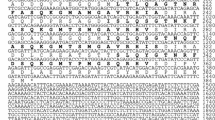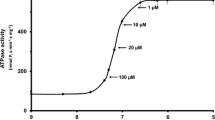Summary
When scallop S1(+LC) (formerly called CaMg S1) is digested by trypsin, the heavy chain degrades while the two light chains remain complexed to each other and a peptide fragment of the heavy chain. The three components of the complex comigrate during electrophoresis under nondissociating conditions and can be purified by chromatography and concentrated by precipitation with ammonium sulphate in the presence of millimolar calcium ions. The truncated regulatory light chain remains associated with the binary complex consisting of the peptide and essential light chain as long as divalent cations are present; in the presence of EDTA it dissociates. This behaviour of the light chains-peptide complex mimics that of the intact molecule.
The effect of bound light chains and bound actin on the susceptibility to tryptic digestion was studied using scallop S1(+LC) and S1(−LC) (EDTA S1 according to previous nomenclature). The heavy chains of both types of S1 are labile and have two main sites susceptible to proteolysis. Tryptic digestion on site A produces an N-terminal peptide of around 70 000 and a C-terminal 24 000 fragment from S1(+LC) and a 20 000 C-terminal fragment from S1(−LC); the latter is prone to further proteolysis. Thus S1(−LC), produced in the absence of bound regulatory light chain is shorter on the C-terminal end. Proteolysis on site A abolishes actin-activated ATPase activity; the latter is prevented by digesting acto-S1. The rate of tryptic digestion on site B is somewhat slower than on site A; when either S1 is split at this site an N-terminal 63 000 peptide is produced. The corresponding C-terminal peptide can be obtained from acto-S1 when hydrolysis on site A is prevented; this is estimated as around 31 000 derived from S1(+LC) and 28 000 derived from S1(−LC).
The results are compared with similar experiments where vertebrate subfragments were digested by trypsin and the possible localization of the light-chain binding peptide in the intact heavy chain is discussed.
Similar content being viewed by others
References
BAGSHAW, C. R. & KENDRICK-JONES, J. (1979) Characterization of homologous divalent cation binding sites of vertebrate and molluscan myosins using electron paramagnetic resonance spectroscopy.J. molec. Biol. 130, 317–36.
BALINT, M., SRETER, F. A. & GERGELY, J. (1975) Fragmentation of myosin by papain. Studies on myosin from adult fast and slow skeletal and cardiac and embryonic muscle.Archs Biochem. Biophys. 168, 557–66.
BENNETT, A., PATEL, N., WELLS, C. & BAGSHAW, C. R. (1984) 8-Anilo-1-naphthalene-sulphonate, a fluorescent probe for the regulatory light chain binding site of scallop myosin.J. Musc. Res. Cell Motility 5, 165–82.
BURKE, M., SIVARAMAKRISHNAN, M. & KAMALAKANNAN, V. (1983) Evidence for the role of the COOH-terminal region of myosin subfragment 1 heavy chain in the binding of the alkali light chain.Biophys. J. 41, 103a.
CHANTLER, P., SELLERS, J. R. & SZENT-GYÖRGYI, A. G. (1981) Cooperativity in scallop myosin.Biochemistry 20, 210–6.
CHANTLER, P. D. & SZENT-GYÖRGYI, A. G. (1980) Regulatory light-chains and scallop myosin: Full dissociation, reversibility and co-operative effect.J. molec. Biol. 138, 473–92.
EBASHI, S. & KODAMA, A. (1965) A new protein factor promoting aggregation of tropomyosin.J. Biochem. 58, 107–8.
FLICKER, P. F., WALLIMANN, T. & VIBERT, P. (1983) Electron microscopy of scallop myosin: Location of the regulatory light chains.J. molec. Biol. 169, 723–41.
HARDWICKE, P. M. D., WALLIMANN, T. & SZENT-GYÖRGYI, A. G. (1983) Light chain movement and regulation in scallop myosin.Nature 301, 478–82.
LAEMMLI, U. K. (1970) Cleavage of structural proteins during the assembly of the head of bacteriophage T4.Nature 227, 80–1.
LOVELL, S. J. & HARRINGTON, W. F. (1981) Measurement of the fraction of myosin heads bound to actin in rabbit myofibrils in rigor.J. molec. Biol. 149, 659–74.
MARIANNE-PEPIN, T., MORNET, D., AUDEMARD, E., MARTIN, F. & KASSAB, R. (1982a) Structural organization of the heavy chain of chicken gizzard myosin.J. Musc. Res. Cell Motility 3, 463.
MARIANNE-PEPIN, T., MORNET, D., BERTRAND, R. & KASSAB, R. (1982b) Characterization of the COOH-terminal 25K segment of the head heavy chain of smooth muscle myosin as a fundamental actin binding region.J. Musc. Res. Cell Motility 3, 464.
MATSUDAIRA, P. T. & BURGESS, D. R. (1978) SDS microslab linear gradient polyacrylamide gel electrophoresis.Analyt. Biochem. 87, 386–96.
MORNET, D., BERTRAND, R., PANTEL, P., AUDEMARD, E. & KASSAB, R. (1981a) Structure of the actin-myosin interface.Nature 292, 301–6.
MORNET, D., PANTEL, P., BERTRAND, R., AUDEMARD, E. & KASSAB, R. (1981b) Isolation and characterization of the trypsin-modified myosin-S1 derivatives.FEBS Lett. 123, 54–8.
OKAMOTO, Y. & YOUNT, R. G. (1983) Identification of an active site peptide of myosin after photoaffinity labeling.Biophys. J. 41, 298a.
PERRIE, W. T. & PERRY, S. V. (1970) An electrophoretic study of the low-molecular-weight components of myosin.Biochem. J. 119, 31–8.
STAFFORD, W. F. & SZENT-GYÖRGYI, A. G. (1978) Physical characterization of myosin light chains.Biochemistry 17, 607–14.
STAFFORD, W. F., SZENTKIRALYI, E. M. & SZENT-GYÖRGYI, A. G. (1979) Regulatory properties of single-headed fragments of scallop myosin.Biochemistry 24, 5273–80.
SUTOH, K. (1983) Mapping of actin binding sites on the heavy chain of myosin subfragment 1.Biochemistry 22, 1579–85.
SZENT-GYÖRGYI, A. G., SZENTKIRALYI, E. M. & KENDRICK-JONES, J. (1973) The light chains of scallop myosin as regulatory subunits.J. molec. Biol. 74, 179–203.
SZENTKIRALYI, E. M. (1982) Scallop regulatory and essential light chains complex with the same heavy chain peptide fragment.Biophys. J. 37, 399a.
VIBERT, P. & CRAIG, R. (1983) Three dimensional reconstruction of thin filaments decorated with a Ca++-regulated myosin.J. molec. Biol. 157, 299–319.
WALLIMANN, T. & SZENT-GYÖRGYI, A. G. (1981) An immunological approach to myosin light-chain function in thick filament linked regulation. 2. Effects of anti-scallop myosin light chain antibodies. Possible regulatory role for the essential light chain.Biochemistry 20, 1188–97.
WALLIMANN, T., HARDWICKE, P. M. D. & SZENT-GYÖRGYI, A. G. (1982) Regulatory and essential light-chain interactions in scallop myosin. II. Photochemical cross-linking of regulatory and essential light-chains by heterobifunctional reagents.J. molec. Biol. 156, 153–73.
WEBER, K. & OSBORN, M. (1969) The reliability of molecular weight determination by dodecylsulfate-polyacrylamide gel electrophoresis.J. biol. Chem. 224, 4402–12.
WEEDS, A. G. & POPE, B. (1977) Studies on the chymotryptic digestion of myosin. Effects of divalent cations on proteolytic susceptibility.J. molec. Biol. 111, 129–57.
WELLS, C. & BAGSHAW, C. R. (1983) Segmental flexibility and head to head interaction in scallop myosin. A study using saturation transfer electron paramagnetic resonance spectroscopy.J. molec. Biol. 164, 137–57.
YAMAMOTO, K. & SEKINE, T. (1979) Interaction of myosin subfragment 1 with actin. III. Effect of cleavage of the subfragment-1 heavy chain on its interaction with actin.J. Biochem. 86, 1869–81.
Author information
Authors and Affiliations
Rights and permissions
About this article
Cite this article
Szentkiralyi, E.M. Tryptic digestion of scallop S1: evidence for a complex between the two light-chains and a heavy-chain peptide. J Muscle Res Cell Motil 5, 147–164 (1984). https://doi.org/10.1007/BF00712153
Received:
Revised:
Issue Date:
DOI: https://doi.org/10.1007/BF00712153




